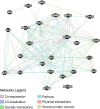Oncogenes associated with drug resistance in ovarian cancer
- PMID: 24997551
- PMCID: PMC11824102
- DOI: 10.1007/s00432-014-1765-5
Oncogenes associated with drug resistance in ovarian cancer
Abstract
Purpose: Oncogenes play pivotal roles in the development of cancer, and disturbances in their expression have been implicated in drug resistance. However, an overview of the contribution of oncogenes to drug resistance in ovarian cancer has not previously been reported. This study aimed to review the drug resistance-related oncogenes in ovarian cancer and precisely determine their relationships.
Methods: The oncogenes associated with drug resistance in ovarian cancer from available papers were summarized, and a comprehensive bioinformatics analysis including pathway enrichment, biological processes annotation, protein/gene interaction and microRNA-mRNA interaction was performed.
Results: Total of 25 oncogenes contributing to drug resistance in ovarian cancer was integrated and further analyzed. An oncogene-mediated drug resistance pathway that explains the associations of 21 of these oncogenes in drug resistance was drafted on the basis of previously published papers. The downstream location of v-akt murine thymoma viral oncogene (AKT) and B-cell CLL/lymphoma 2-associated X protein (BAX) with respect to many other oncogenes was determined, indicating that the two genes may play a central role, and the AKT- and BAX-mediated signaling are the main pathways accounting for the involvement of oncogenes in drug resistance in ovarian cancer. Besides, the annotation of biological process indicated that the apoptosis (cell death) and phosphorylation (phosphate metabolic process) might be the two major biological routes through which oncogenes contribute to drug resistance in ovarian cancer. In addition, on the basis of the comprehensive analysis of microRNA-mRNA interactions, 11 microRNAs were identified to be targeted at least 7 of the 25 oncogenes, indicating that those microRNAs could be an important regulator of the 25 oncogenes. Collectively, by integrating and further analyzing the available data on these oncogenes, this study contributes to improving our understanding of the mechanisms by which their expression leads to drug resistance in this ovarian cancer.
Conflict of interest statement
The authors confirm that they have no competing interests.
Figures




Similar articles
-
A rapid and systematic review of the clinical effectiveness and cost-effectiveness of topotecan for ovarian cancer.Health Technol Assess. 2001;5(28):1-110. doi: 10.3310/hta5280. Health Technol Assess. 2001. PMID: 11701100
-
A rapid and systematic review of the clinical effectiveness and cost-effectiveness of paclitaxel, docetaxel, gemcitabine and vinorelbine in non-small-cell lung cancer.Health Technol Assess. 2001;5(32):1-195. doi: 10.3310/hta5320. Health Technol Assess. 2001. PMID: 12065068
-
Topotecan, pegylated liposomal doxorubicin hydrochloride and paclitaxel for second-line or subsequent treatment of advanced ovarian cancer: a systematic review and economic evaluation.Health Technol Assess. 2006 Mar;10(9):1-132. iii-iv. doi: 10.3310/hta10090. Health Technol Assess. 2006. PMID: 16545208
-
The Black Book of Psychotropic Dosing and Monitoring.Psychopharmacol Bull. 2024 Jul 8;54(3):8-59. Psychopharmacol Bull. 2024. PMID: 38993656 Free PMC article. Review.
-
A systematic review and economic evaluation of epoetin alpha, epoetin beta and darbepoetin alpha in anaemia associated with cancer, especially that attributable to cancer treatment.Health Technol Assess. 2007 Apr;11(13):1-202, iii-iv. doi: 10.3310/hta11130. Health Technol Assess. 2007. PMID: 17408534
Cited by
-
Analysis of microarray-identified genes and microRNAs associated with drug resistance in ovarian cancer.Int J Clin Exp Pathol. 2015 Jun 1;8(6):6847-58. eCollection 2015. Int J Clin Exp Pathol. 2015. PMID: 26261572 Free PMC article.
-
Identification of genes predicting chemoresistance and short survival in ovarian cancer.Transl Cancer Res. 2024 Aug 31;13(8):4354-4371. doi: 10.21037/tcr-23-2157. Epub 2024 Aug 6. Transl Cancer Res. 2024. PMID: 39262489 Free PMC article.
-
Bibliometric and visualized analysis of drug resistance in ovarian cancer from 2013 to 2022.Front Oncol. 2023 May 18;13:1173863. doi: 10.3389/fonc.2023.1173863. eCollection 2023. Front Oncol. 2023. PMID: 37324006 Free PMC article. Review.
-
A Non-Disposable Electrochemical Sensor Based on Laser-Synthesized Pd/LIG Nanocomposite-Modified Screen-Printed Electrodes for the Detection of H2O2.Sensors (Basel). 2024 Mar 22;24(7):2043. doi: 10.3390/s24072043. Sensors (Basel). 2024. PMID: 38610254 Free PMC article.
-
Diallyl trisulfide alleviates chemotherapy sensitivity of ovarian cancer via the AMPK/SIRT1/PGC1α pathway.Cancer Sci. 2023 Feb;114(2):357-369. doi: 10.1111/cas.15627. Epub 2022 Dec 12. Cancer Sci. 2023. PMID: 36309839 Free PMC article.
References
-
- Abe A, Minaguchi T, Ochi H, Onuki M, Okada S, Matsumoto K, Satoh T, Oki A, Yoshikawa H (2013) PIK3CA overexpression is a possible prognostic factor for favorable survival in ovarian clear cell carcinoma. Hum Pathol 44:199–207 - PubMed
-
- Acosta KB, Tibolla MM, Tiscornia MM, Lorenzati MA, Zapata PD (2011) Recent patents related to phosphorylation signaling pathway on cancer. Recent Pat DNA Gene Seq 5:175–184 - PubMed
-
- Aunoble B, Sanches R, Didier E, Bignon YJ (2000) Major oncogenes and tumor suppressor genes involved in epithelial ovarian cancer (review). Int J Oncol 16:567–576 - PubMed
Publication types
MeSH terms
Substances
LinkOut - more resources
Full Text Sources
Other Literature Sources
Medical
Research Materials

